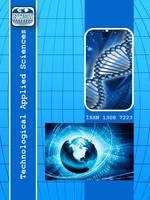KINECT NOKTA BULUTU VERİSİNE METRİK TABANLI YENİ BİR SINIFLANDIRMA YAKLAŞIMI
Sınıflandırma, Nokta Bulutu, Mean-Shift, Nesne tanıma, Kinect
A METRIC BASED NOVEL CLASSIFICATION APPROACH TO KINECT POINT CLOUD DATA
Classification, Point Cloud, Mean-Shift, Object Detection, Kinect,
___
- Eskandari, A.R. and Kouchaki, Z., (2012). Regular Shapes
- Detection in Satellite Images, Malaysian Journal of Computer
- Science, vol:25, no:1, pp:56-66.
- Lai, K. and Fox, D., (2010). Object Recognition in 3D Point
- Clouds Using Web Data and Domain Adaptation, The International
- Journal of Robotics Research, vol:29, no:8, pp:1019-1037.
- Schnabel, R., Wahl, R., Klein, R., (2007). Efficient RANSAC for
- Point-Cloud Shape Detection, Computer Graphics Forum,
- vol:26, no: 2, pp:214-226.
- Hao, W., Wang, Y., Ning, X., Zhao, M., Zhang, J., Shi, Z.,
- and Zhang, X., (2013). Automatic Building Extraction from
- Terrestrial Laser Scanning Data, Advances in Electrical and
- Computer Engineering, vol:13, no:3, pp:11-16.
- Zhang, Z., (2012). Microsoft Kinect Sensor and Its Effect,
- MultiMedia, IEEE, vol:19, no:2, pp:4-12.
- Zhang, M., Zhang, Z., Chang, Y., Esche, S. K., Chassapis, C.,
- (2015). Kinect-based Universal Range Sensor and its Application
- in Educational Laboratories, International Journal of Online
- Engineering (IJOE), vol:11, no:2, pp:26-35.
- Khoshelham, K. and Elberink, S.O., (2012). Accuracy and
- Resolution of Kinect Depth Data for Indoor Mapping Applications,
- Sensors, Vol:12, No:2, pp:1437-1454.
- Ozbay, E. and Cinar, A., (2013). 3D Reconstruction Technique
- With Kinect and Point Cloud Computing, in Proc. 3rd World
- Conference on Information Technology, vol:3, pp:1748-1754.
- Ozbay, E., Cinar, A., (2013). A Novel Approach to Smoothing on
- d Structured Adaptive Mesh of The Kinect-Based Models, in Proc.
- th International Conference on Advanced Information
- Technologies and Applications, pp:13-22.
- Atmosukarto, I. and Shapiro, L.G., (2008). A Learning Approach
- to 3D Object Representation for Classification, in Proc.
- Structural, Syntactic, and Statistical Pattern Recognition,
- Pp:267-276.
- Wei, X., Phung, S.L., and Bouzerdoum, A., (2014). Object
- segmentation and classification using 3-D range camera, Journal
- of Visual Communication and Image Representation, Vol:25, No:1,
- pp:74-85.
- Berger, K., Ruhl, K., Schroeder, Y., Bruemmer, C., Scholz, A.,
- and Magnor, M.A., (2011). Markerless Motion Capture using
- multiple Color-Depth Sensors, In VMV pp:317-324.
- Zalevsky, Z., Shpunt, A., Malzels, A., and Garcia, J., (2013).
- Method and system for object reconstruction” Patent No
- ,400,494, Washington Patent and Trademark Office.
- Smisek, J., Jancosek, M., Pajdla, T., (2013). 3D with Kinect,
- In Consumer Depth Cameras for Computer Vision Springer London,
- Pp:3-25.
- Rusu, R.B. and Cousins, S., (2011). 3D is here: Point Cloud
- Library (PCL), in Proc. 2011 IEEE International Conference on
- Robotics and Automation (ICRA), pp. 1-4.
- Khoshelham, K., (2011). Accuracy Analysis Of Kinect Depth Data.
- ISPRS workshop laser scanning, vol:38, no:5, in Proc.
- ISPRS Workshop Laser Scanning.
- Tombari, F. and Stefano, L.D., (2011). 3d Data Segmentation by
- Local Classification and Markov Random Fields, in Proc.
- International Conference on 3D Imaging, Modeling, Processing,
- Visualization and Transmission, pp:212-219.
- Weinberger, K.Q., Blitzer, J., and Saul, L.K., (2005). Distance
- Metric Learning for Large Margin Nearest Neighbor
- Classification. The Journal of Machine Learning Research,
- vol:10, pp:207-244.
- Altman, N.S., (1992). An Introduction to Kernel tnd Nearest-
- Neighbor Nonparametric Regression, The American Statistician,
- vol:46, no:3, pp:175-185.
- Cheng, Y., (1995). Mean Shift, Mode Seeking, and Clustering,
- Pattern Analysis and Machine Intelligence, IEEE Transactions,
- Vol:17, no:8, pp:790-799.
- Jaskowiak, P.A. and Campello, R.J.G.B., (2011). Comparing
- Correlation Coefficients as Dissimilarity Measures for Cancer
- Classification in Gene Expression Data, in Proc. Brazilian
- Symposium on Bioinformatics, pp. 1-8.
- Rottensteiner, F., Sohn, G., Jung, J., Gerke, M., Baillard, C.,
- Benitez, S., and Breitkopf, U., (2012). The ISPRS Benchmark on
- Urban Object Classification and 3d Building Reconstruction,
- ISPRS Ann. Photogramm. Remote Sens. Spat. Inf. Sci, Vol:1, No:3,
- pp:293-298.
- Klasing, K., Wollherr, D., and Buss, M., (2008). A Clustering
- Method for Efficient Segmentation of 3d Laser Data, in Proc.
- IEEE International Conference on Robotics and Automation (ICRA),
- , pp:4043-4048.
- Kim, T.K., Kee, S.C., and Kim, S.R., (2001). Real-time
- Normalization and Feature Extraction of 3D Face Data Using
- Curvature Characteristics, in Proc. 10th IEEE International
- Workshop on Robot and Human Interactive Communication,
- Pp:74-79.
- Hwang, J.P., Baek, J., Choi, B., and Kim, E., (2015). A Novel
- Part-Based Approach to Mean-Shift Algorithm for Visual Tracking,
- International Journal of Control, Automation and Systems,
- Vol:13, No:2, pp:443-453.
- Talu, M.F., Türkoğlu, İ., and Cebeci, M., (2010). Real-time
- Kernel Based Object Tracking Using Mean Shift, in Proc. 18th
- IEEE Signal Processing and Communications Applications (SIU),
- Pp:328-331.
- Yao, W., Hinz, S., and Stilla, U., (2009). Object Extraction
- Based on 3D-segmentation of Lidar Data by Combining Mean Shift
- with Normalized Cuts: Two Examples from Urban Areas, in Proc.
- IEEE Urban Remote Sensing Event, pp:1-6.
- Başlangıç: 2009
- Yayıncı: E-Journal of New World Sciences Academy
KINECT NOKTA BULUTU VERİSİNE METRİK TABANLI YENİ BİR SINIFLANDIRMA YAKLAŞIMI
HASAN KARABULUT, MEHMET AKİF ERDEN, ERDEM ÖZKURT, AHMET NUSREV TANRIVERDI, ALPEREN YILMAZ, MUSTAFA TÜRKMEN, SÜLEYMAN GÜNDÜZ
AMASYA KENTİ ÖZELİNDE YAPI DIŞ CEPHE İSKELELERİNİN İŞ SAĞLIĞI VE GÜVENLİĞİ YÖNÜYLE DEĞERLENDİRİLMESİ
PTA YÖNTEMİ İLE GERÇEKLEŞTİRİLEN FE-CR-W-B-C KOMPOZİT KAPLAMASININ MİKROYAPI VE MEKANİK ÖZELLİKLERİ
